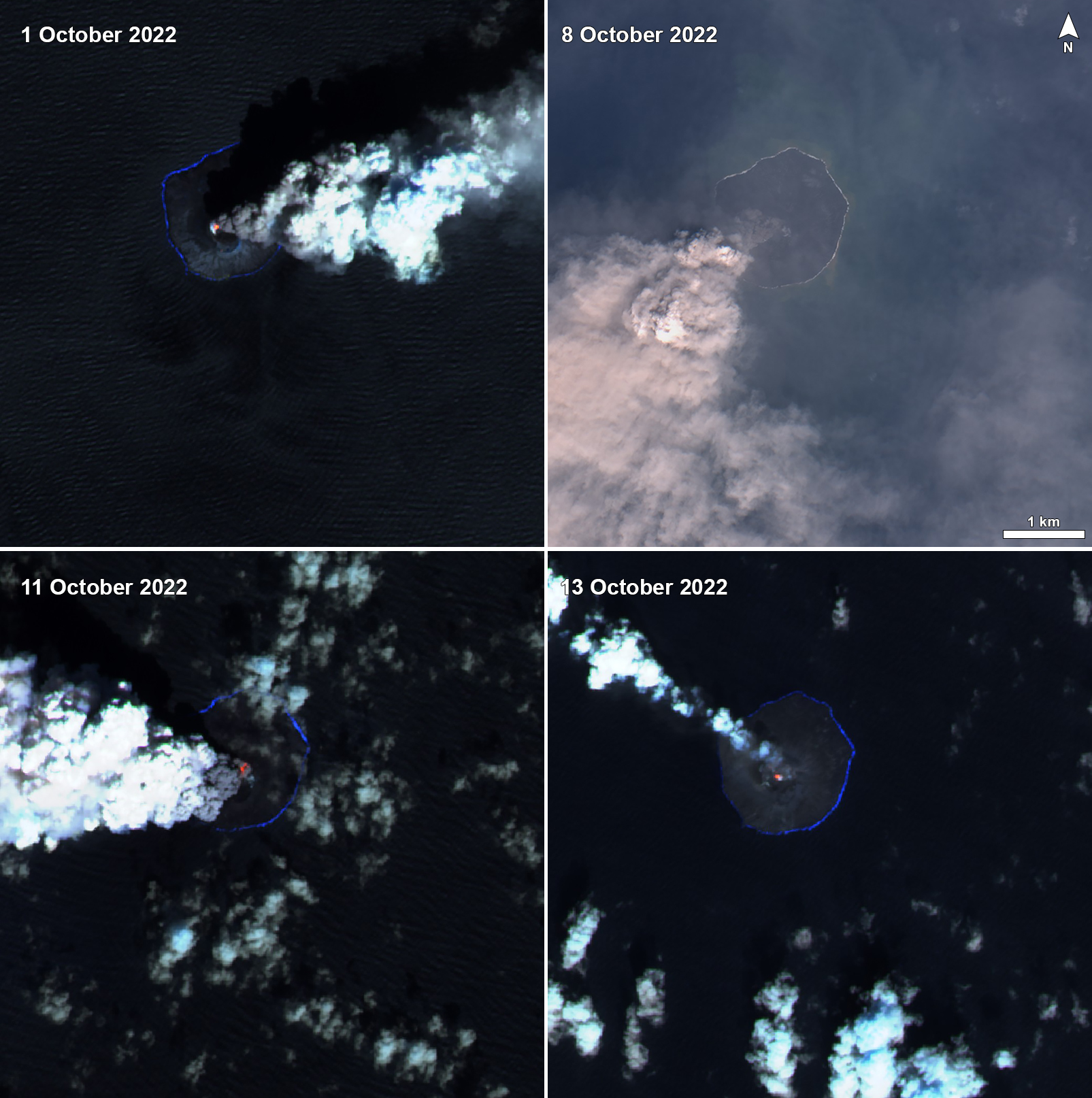Report on Nishinoshima (Japan) — December 2022
Bulletin of the Global Volcanism Network, vol. 47, no. 12 (December 2022)
Managing Editor: Benjamin Andrews.
Edited by Kadie L. Bennis.
Nishinoshima (Japan) New eruption with ash plumes and fumarolic activity during October 2022
Please cite this report as:
Global Volcanism Program, 2022. Report on Nishinoshima (Japan) (Bennis, K.L., and Andrews, B., eds.). Bulletin of the Global Volcanism Network, 47:12. Smithsonian Institution.
Nishinoshima
Japan
27.247°N, 140.874°E; summit elev. 100 m
All times are local (unless otherwise noted)
Nishinoshima is a small island located about 1,000 km S of Tokyo in the Ogasawara Arc in Japan. The island is a summit of a massive submarine volcano that has prominent satellite peaks to the S, W, and NE. Eruptions date back to 1973; the most recent eruption period occurred during August 2021 and was characterized by ash eruptions (BGVN 46:10). This report covers a new eruption during October 2022 that consisted of ash plumes, thermal activity, and fumarolic activity based on reports from the Japan Meteorological Agency (JMA) monthly reports, the Japan Coast Guard (JCG), which makes regular observation overflights, the Tokyo Volcano Ash Advisory Center (VAAC), and satellite data.
Activity since August 2021 has been relatively quiet. White gas-and-steam emissions were reported intermittently during January and March-September 2022 from multiple locations, including within the central crater of the pyroclastic cone, the central crater, and the crater rim. Yellow-brown and yellow-green discolored water were also visible on clear weather days along the coasts of the island. No visual activity was reported during February 2022. On 15 March a band of yellow-green discolored water was observed extending 10 km NNW. In addition, a white plume from fumaroles was reported by JMA on 15 March that rose from the central crater of the pyroclastic cone as high as 6 km and drifted 6 km NNW. On 29 March and 18 April fumaroles generated a white plume that rose 1 km above the pyroclastic cone (figure 116); compared to the activity on 15 March, fumarolic activity increased and the volume of discolored water decreased. On 16 May white gas-and-steam emissions rose 200 m above the crater. On 17 June and 11 July, fumaroles generated a white plume that rose 1.5 km above the crater.
Eruptive activity began on 1 October, according to JMA; on 1 October a volcanic plume rose 1.6 km above the crater rim at 1040. JMA reported that ash plumes rose as high as 3.5 km above the crater and drifted in different directions during 1-12 October, based on HIMAWARI satellite images. According to Tokyo VAAC notices, ash plumes during 1-12 October rose to 1.8-3.7 km altitude and drifted in different directions. An overflight by the Japan Coast Guard (JCG) made on 12 October at 1300 showed that the eruptive activity had stopped; a white plume from a fumarole rose from the central crater to 3.6 km above the crater, as well as on the SE side of the pyroclastic cone. Ash deposits from the eruptive activity were observed on the W side of the island. Discolored brown and yellow-green water were visible around the coasts of the island.
Intermittent low-to-moderate thermal anomalies were recorded in the MIROVA graph (Middle InfraRed Observation of Volcanic Activity) during late June through mid-October 2022 (figure 117). Three thermal signatures were detected on 9 October, according to data from the MODVOLC thermal algorithm, which indicated days of stronger thermal activity. This was also reflected in Sentinel-2 infrared satellite imagery, which showed a persistent thermal anomaly at the crater during the eruption period in October, many of which were accompanied by ash plumes that drifted E, SW, W, and NW (figure 118).
 |
Figure 117. The MIROVA graph showed intermittent low-to-moderate thermal anomalies at Nishinoshima during mid-June through mid-October 2022. Courtesy of MIROVA. |
Geological Summary. The small island of Nishinoshima was enlarged when several new islands coalesced during an eruption in 1973-74. Multiple eruptions that began in 2013 completely covered the previous exposed surface and continued to enlarge the island. The island is the summit of a massive submarine volcano that has prominent peaks to the S, W, and NE. The summit of the southern cone rises to within 214 m of the ocean surface 9 km SSE.
Information Contacts: Japan Meteorological Agency (JMA), 1-3-4 Otemachi, Chiyoda-ku, Tokyo 100-8122, Japan (URL: http://www.jma.go.jp/jma/indexe.html); Japan Coast Guard (JCG) Volcano Database, Hydrographic and Oceanographic Department, 3-1-1, Kasumigaseki, Chiyoda-ku, Tokyo 100-8932, Japan (URL: https://www1.kaiho.mlit.go.jp/GIJUTSUKOKUSAI/kaiikiDB/kaiyo18-e1.htm); Tokyo Volcanic Ash Advisory Center (VAAC), 1-3-4 Otemachi, Chiyoda-ku, Tokyo 100-8122, Japan (URL: http://ds.data.jma.go.jp/svd/vaac/data/); MIROVA (Middle InfraRed Observation of Volcanic Activity), a collaborative project between the Universities of Turin and Florence (Italy) supported by the Centre for Volcanic Risk of the Italian Civil Protection Department (URL: http://www.mirovaweb.it/); Hawai'i Institute of Geophysics and Planetology (HIGP) - MODVOLC Thermal Alerts System, School of Ocean and Earth Science and Technology (SOEST), Univ. of Hawai'i, 2525 Correa Road, Honolulu, HI 96822, USA (URL: http://modis.higp.hawaii.edu/).



